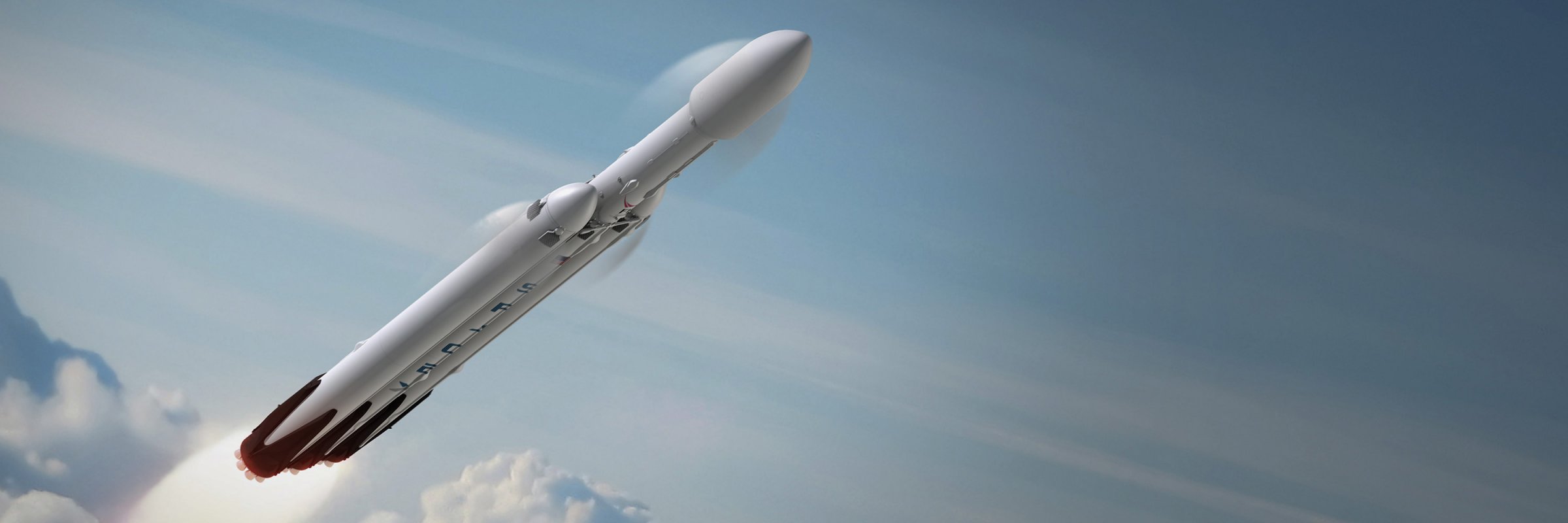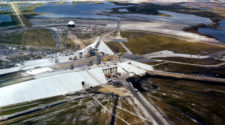After a ‘very fast fire’, a four-month hiatus, a complicated anomaly, and a general shaking of confidence, SpaceX was finally able to launch – and land – their Falcon 9 rocket once again last month. This is the first of 27 missions for 2017, a slate of launches that will not only introduce the final version of the Falcon 9, but will also include SpaceX’s next great launch vehicle, the Falcon Heavy.
Launching from the Kennedy Space Center at Launch Pad 39-A, the maiden flight of the Falcon Heavy will lift off with 5,180,000 pounds of thrust. It’s two boosters will run through most of their fuel first, then separate from the center core to prepare for landing maneuvers, a trademark of SpaceX’s technology. Firing up its center engine during descent, and with the four steering grids, the two boosters simultaneously maneuver themselves to soft landings onto either one of SpaceX’s barges or landing pads on mainland. Cruising far above them, the center core separates from the upper stage, delivering the demonstration payload into orbit. As before, the main stage flips its orientation, and begins its own decent. If everything goes as planned, SpaceX will be able to bring home all of its three rockets

Announced in April of 2011, the Falcon Heavy builds off the success of the Falcon 9 program, doubling SpaceX’s current payload capacity. With the goal of almost full reusability, and a price tag of only $90 million, the Falcon Heavy rocket acts as the next step of SpaceX’s journey to Mars.
At the center of the rocket stands a Falcon 9 Full Thrust, and on either side are two Falcon 9 first stages, which act as boosters for the rocket. Using Falcon 9 parts eliminates the need to develop alternative boosters, cutting down on developmental costs and complexity while increasing reliability. Each core has nine engines, and with each engine having a thrust-to-weight ration of 1:180, this will be both the most efficient and powerful rocket on the market.

Stacked on top on the center core is the upper stage, which is powered by another Merlin engine. However this one is different, designed both to work in a vacuum and have a long and wider nozzle than those at the base of the rocket. A wider nozzle is necessary for optimal performance in a vacuum. This is because a rocket engine is most efficient when the pressure of the propellant exiting the nozzle is equal to its surrounding. For this type of nozzle, the wider the exit point, the lower the pressure.
While the Falcon Heavy is a technological marvel, the cost alone stands as a testament to the culture of persistence at SpaceX. The staggeringly low $90 million price tag allows for a lower “price-per-pound” for space missions, which brings launch costs down to as low as $750 per pound to low Earth orbit. Compare that to almost $6,000 per pound for the Delta IV Heavy – currently the most powerful rocket – and the decision of which to go with is quite clear. If anything, it shows the economic effectiveness of reusability.

Unsurprisingly, Elon Musk has been adamant about utilizing reusable rockets, a step that he believes is necessary in order to even consider colonizing other worlds. In September 2016, Musk unveiled the first details about the long rumored Interplanetary Transport System, an exploration platform that could open up the entire solar system to us. However, as inspiring as that is, it important to remind ourselves not to get too distracted with the next generation of space systems. The hard working scientists and engineers must remain focused, and take this one day at a time, perfecting the Falcon 9 and preparing for more rapid reuse and frequent flights.
A goal of the Falcon Heavy is the completion of the 2018 Red Dragon mission. This will be SpaceX’s first time venturing out of Earth’s orbit, working with NASA to land their Dragon v2 Spacecraft on the surface of Mars. The team is working closely with NASA engineers, and is currently on track for a 2018 launch date, delivering their craft on a Trans-Mars Injection using a Falcon Heavy. NASA will be providing technical support for the company, sharing all the necessary information that they have learned from their previous Mars missions. If they succeed, then they shall be the first company to land on another planet in our solar system, a feat not many countries can even claim. Looking forward with optimism, it seems as if SpaceX has a bright future ahead of them.




